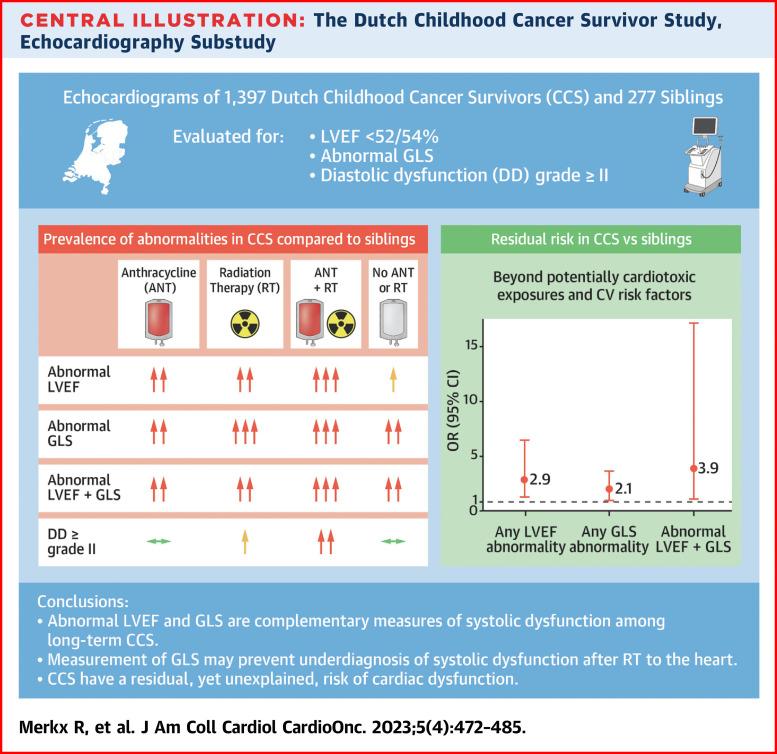Extensive Cardiac Function Analyses Using Contemporary Echocardiography in Childhood Cancer Survivors A DCCSS LATER Study
Remy Merkx, MD,a Jan M. Leerink, MD,b E. (Lieke) A.M. Feijen, PHD,c Esmée C. de Baat, MD,c Louise Bellersen, MD,d Dorine Bresters, MD, PHD,c Elvira C. van Dalen, MD, PHD,c Eline van Dulmen-den Broeder, MD, PHD,e Margriet van der Heiden-van der Loo, PHD,f Marry M. van den Heuvel-Eibrink, MD, PHD,c,g,h Judith L. Kok, PHD,c Marloes Louwerens, MD,i Angela H.E.M. Maas, MD, PHD,d Sebastian J.C.M.M. Neggers, MD, PHD,j Cécile M. Ronckers, PHD,c,k Jop C. Teepen, PHD,c Arco J. Teske, MD, PHD,l Wim J.E. Tissing, MD, PHD,c,m Andrica C.H. de Vries, MD, PHD,c,g Gert Weijers, PHD,a Chris L. de Korte, PHD,a Jacqueline Loonen, MD, PHD,n Annelies M.C. Mavinkurve-Groothuis, MD, PHD,c Helena J.H. van der Pal, MD, PHD,c Leontien C.M. Kremer, MD, PHD,c,h,o Wouter E.M. Kok, MD, PHD,b Livia Kapusta, MD, PHD,p,q on behalf of the Dutch LATER Study Group
Background
Childhood cancer survivors (CCS) are at risk for cardiotoxicity.
Objectives
We sought to assess how cardiac dysfunction measurements in CCS overlap and are differentially influenced by risk factors.
Methods
This cross-sectional Dutch Childhood Cancer Survivor Study evaluated echocardiograms of 1,397 ≥5-year CCS and 277 siblings. Of CCS, n = 1,254 received cardiotoxic (anthracyclines/mitoxantrone/radiotherapy involving the heart region [RTheart]) and n = 143 received potentially cardiotoxic (cyclophosphamide, ifosfamide, or vincristine) therapy. We assessed demographic, treatment-related, and traditional cardiovascular risk factors for cardiac dysfunction using multivariable logistic regression.
Results
CCS were a median of 26.7 years after diagnosis; 49% were women. Abnormal left ventricular ejection fraction (LVEF) (defined as <52% in men, <54% in women) occurred most commonly in CCS treated with anthracyclines and RTheart combined (38%). Age/sex-specific abnormal global longitudinal strain (GLS) occurred most commonly in CCS treated with RTheart, either with (41%) or without (38%) anthracyclines. Of CCS with normal LVEF, 20.2% showed abnormal GLS. Diastolic dysfunction grade ≥II was rare. Abnormal LVEF was mainly associated with female sex, anthracycline dose, and only in women, RTheart dose. Abnormal GLS was associated with female sex, RTheart dose, diastolic blood pressure, and only in women, anthracycline dose. Cyclophosphamide, ifosfamide, and vincristine were not associated with LVEF or GLS. Compared with siblings, CCS showed higher risk of abnormal LVEF (OR: 2.9; 95% CI: 1.4-6.6) and GLS (OR: 2.1; 95% CI: 1.2-3.7), independent of (potentially) cardiotoxic treatment-related and cardiovascular risk factors.
Conclusions
Abnormal LVEF and GLS constitute complementary measures of systolic dysfunction among long-term CCS. Their diagnostic value may differ according to cardiotoxic exposures. Also, CCS have residual, unexplained risk of cardiac dysfunction. (Early Detection of Cardiac Dysfunction in Childhood Cancer Survivors, a DCOG LATER study; NTR7481)
Central Illustration

